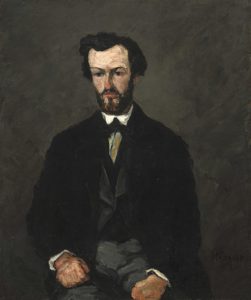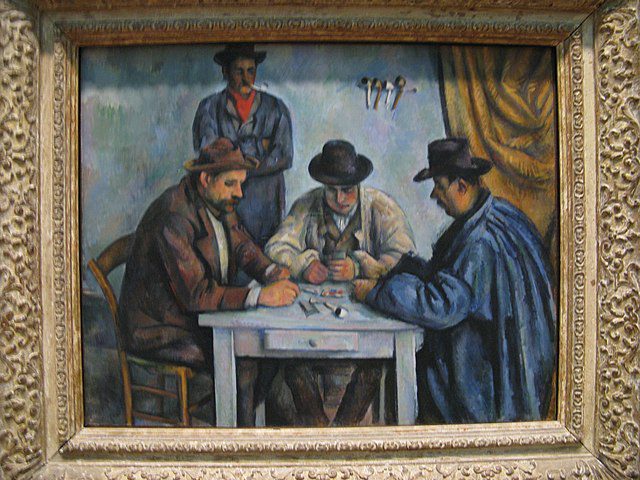Top 15 Interesting Facts about Paul Cezanne

Paul Cézanne- by J. Rewald, The Paintings of Paul Cézanne: A Catalogue Raisonné at the National Gallery of Art, Washington, D.C.- Wikimedia Commons
Originally published by Christine M in March 2020 and Updated by Ruth in August 2022
If you visit Aix- en- Provence you will come across many paintings by Paul Cezanne, more than you might in any other part of France or the world. You might even stumble upon Le Terrain des Peintres, a park which he painted and also where he painted from in the latter days of his life.
Born in January 19th 1839, Cezanne charted his own path as far as his art. Right from the start, he had to negotiate with his affluent father so he could pursue art. His works were also, for the longest time, misunderstood and discredited by the public; they, however, moved away from impressionism and challenged conventional values of painting in the 19th century. Cezanne’s works displayed personal expression and integrity, no matter what he was painting.
Some Top 10 Interesting Facts About Paul Cezanne will help understand him better.
1. Cezanne’s works were rejected by the Paris Salon
Paris Salon was the official art exhibition of the Académie des Beaux-Arts in Paris, and the greatest annual art event in the West between 1748 and 1890. It was, therefore, a big deal to have works accepted by this institution.
Cezanne submitted his works every year between 1864 and 1882. They, however, would be sent to Salon des Refuses, which essentially was where rejects were sent to. His painting, The Artist’s Father, Reading “L’Événement” was the only piece accepted- quite amazing that Cezanne didn’t quit!
2. Cezanne did not exhibit his works publicly for 20 years
With the repeated rejection by the Paris Salon, Cezanne exhibited his works with the Impressionists. As his style was already controversial, it leaned more towards this than the contemporary. He however still didn’t fit in with this lot- Impressionism rejected realism in favor of “impressions” created by light and captured in the blink of an eye. Cezanne’s works displayed personal expression.
By the time Cezanne was exhibiting with this group for the third time, he would not exhibit his works publicly for twenty years. This had presented yet another rejection of Cezanne’s craft.
3. Depression almost got the best of Cezanne
Cezanne’s 1867 painting “sorrow” depicts a man crouched over, seemingly grieving. Perhaps a perfect depiction of his life.
Cezanne is said to have been a loner, and the rejection of his works didn’t help the situation as his esteem suffered- the artist was his own number one critic, who rarely liked his paintings, despite spending hours on them and demanding that his models remain absolutely motionless. His processes could, therefore, be arduous for both himself and subjects.
His mood often oscillated between euphoria and despair and the older he grew, the more Cezanne drew away from reality and the world. He despised socializing but had a close friend, Emile Zola in whom he confided his anxieties, as well as a lifelong partner Marie- Hortense Fiquet.
The onset of his diabetes and the discredit that followed after his works getting into Salon des Refuses were perhaps to blame for his deep depression.
4. Cezanne’s expression of his dark periods through art
Cezanne’s work took a heavy-handed and dark pallete around after the 1860s.
With the rejection and fallout with the Impressionists, allegedly due to Cezanne’s awful bedside manner, all of Cezanne’s paintings were in tones of black! However, this dark period in Cezanne’s life yielded works such as Portrait of a Man, Head of an Old Man, Portrait of Uncle Dominic and the first and only work of his to be accepted at the Salon, The Artist’s Father, Reading L’Evenement. He also mostly painted religious scenes and symbols, dreams, and fantasies around this period.
5. Cezanne under family pressure
As already established, the painter haggled with his father over attending art school vis a vis attending law school and joining him in banking. Cezanne was born into a wealthy family and enjoyed his father’s financial support, under whose influence he enrolled in the law school of the University of Aix-en-Provence.
Cezanne had always wanted to study art, so he didn’t last at the law school. He left after two years but it took his mother’s intervention to have his father agree to his studying painting in Paris. He also hid from his father the fact that he had a relationship with one of his painting models and had a son. He didn’t want to be cut off nor offend his father. It happened anyway when his father found out, but he later relented and helped his son and family when they were in financial crisis.
6. Cezanne evaded military service
In 1870, Cezanne moved to L’Estaque in the South of France to avoid the military draft. This would be for the Franco- Prussian war. This evasion was chargeable in a court of law and would otherwise have affected his career. When the war ended, however, Cezanne was cleared of all charges, and moved back to Paris, welcoming the birth of his son whom he did several paintings of. His new small family then moved to Auvers.
7. Camille Pissaro’s influence
Despite his poor experience with the Impressionist movement, Cezanne did make an impressionist friend, Camille Pissaro. They would seem to enjoy each other’s’ company as they painted landscapes together traipsing the countryside despite their different styles.
Pissaro influenced Cezanne’s painting style. He made it lighter! Cezanne moved away from all the dark hues and yielded vibrant paintings such as Melting Snow, L’Estaque, Bouquet in a Delft Vase, Self-portraits and the House of Doctor Gachet in Auvers.
8. Some reprieve for Cezanne
Despite it being a solemn period, Cezanne’s father’s death in 1886 afforded him the opportunity to work with financial security as he inherited his estate. Away from the struggle, and having to ask for support from his father, Cezanne simply thrived with his newly found financial independence. This reprieve was reflected in his works during that period, mostly pleasant landscape art and portraits of his wife and child. Cezanne also had painters come and work in his newly acquired estate, perhaps motivating and firing him up.
9. Cezanne recognized
Over time as Cezanne’s works gained recognition, but he was retreating further and further away from people. In 1895, he climbed St-Victoire Mountain, and worked from a cabin there, giving birth to cubism, with his representation of three-dimensional form. Cezanne rarely had contact with the public during this time. His paintings, though seen were not that accessible.
His reputation solidified and he became a legend- the public heard about him yet they rarely saw him. This was a far cry from the harsh criticism he had earlier received. Legend has it that one time the public threw some of his works at his doorstep asking him to leave town as he was shaming it with his man works that were ending up at Salon des Refuses!
Cezanne did eventually get his pedestal in society.
10. Cezanne’s death

Homage to Cezanne- by zttp://www.wikiart.org/en/maurice-denis/homage-to-cezanne-1900- Wikimedia Commons
In 1906 the painter collapsed while painting outdoors. He soon after suffered pneumonia which caused his death. Not to forget that he was diabetic as well. He was buried in Aix- en- Provence, his birth city.
In his death, Cezanne’s wish for his work was granted, albeit in a larger scope- Autumn Salon threw a ‘Cezanne’s work party’. It held a retrospective of Cezanne’s entire body of work, which caused quite a stir in the painting spheres. Cezanne got his much-desired crown as one of the most influential artists of the century.
Cezanne’s troubles especially with his painting style, and struggle to penetrate the art scene laid the foundation for future art movements like fauvism. It is from his tribulations as an artist that expressionism became mainstream.
In his 46-year-old career, Cezanne created over 900 oil paintings and more than 400 watercolors. While he may not have been understood and was a loner, his words perhaps shed light into his demeanor- “The world doesn’t understand me, and I don’t understand the world, that’s why I’ve withdrawn from it.”
11. Cézanne’s banker father initially didn’t support the artistic talent of his son
Cézanne’s mother, a woman named Anne Elisabeth Honorine Aubert, played an important role in his life. His father, Louis-Auguste Cézanne, on the other hand, didn’t approve of his drawing education and preferred Paul to study law at the University of Aix.
Although he followed the wishes of his father, a banker, he continued to receive drawing lessons as well. After all, his artistic talent was unmistakably obvious during his teenage years.
Cézanne didn’t like the corporate world at all and the only way to pursue an artistic career was to move to Paris, something he did in the year 1861 at the age of 22. Luckily, when he started to become successful, his father changed his mind and eventually ended up supporting the endeavor of his son.
12. Cézanne’s career consisted of 4 distinct artistic periods

Paul Cézanne, French The Large Bathers – Google Art Project – Wikimedia Commons
Paul Cézanne is considered to be one of the greatest artists in history, and especially one of the most influential ones. His rather simple style featuring small brushstrokes which he used to build up complex paintings is easily recognizable.
His career started in the early 1860s when he moved to Paris and we can distinguish 4 different periods in the following decades: 1861-1870, 1870-1878, 1878-1890, and 1890-1906.
13. Cézanne used geometric simplification in his art
One of the most prominent features that Cézanne brought to the world of art was his geometric simplification. He intensely studied whatever he was painting and brought it back to the simplest geometric form it could be reduced to.
This means that he was thinking in terms of cylinders, triangles, cubes, and spheres, to structure his artworks. This remarkable shift in portraying objects was derived from his interest in binocular vision and stereoscopy, a technique to improve the illusion of depth.
14. Cézanne had one of the most expensive paintings ever sold

The Card Players by Paul Cézanne at Metropolitan Museum of Art by Yair Haklai – Wikimedia Commons
A painting called Rideau, Cruchon et Compotier from 1894 sold for a whopping $60.5 million back in 1999, the 4th-highest price ever paid for an artwork at that time. Many of his artworks have sold for incredible sums of money in the past decades.
A work that is known as The Card Players from 1893 was sold for anywhere between $250 million (nearly $290 million today) and $300 million (nearly $350 million today) back in 2011. It was bought by the Royal Family of Qatar and was the highest price ever paid for a painting at that time.
15. Cezanne’s compositions have contributed to new ideas about art
Cezanne positively influenced upcoming artists and lead to the advancement of modern art. Working gradually and quietly, the Cezanne has changed the meaning of art.
Art is now perceived as an organized pictorial language that proceeds to represent perspective in twentieth-century art and artists.
Planning a trip to Paris ? Get ready !
These are Amazon’s best-selling travel products that you may need for coming to Paris.
Bookstore
- The best travel book : Rick Steves – Paris 2023 – Learn more here
- Fodor’s Paris 2024 – Learn more here
Travel Gear
- Venture Pal Lightweight Backpack – Learn more here
- Samsonite Winfield 2 28″ Luggage – Learn more here
- Swig Savvy’s Stainless Steel Insulated Water Bottle – Learn more here
Check Amazon’s best-seller list for the most popular travel accessories. We sometimes read this list just to find out what new travel products people are buying.














